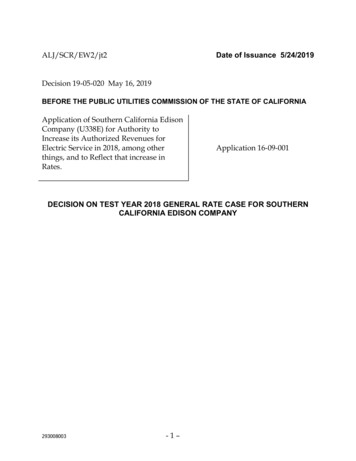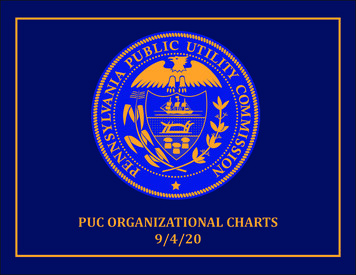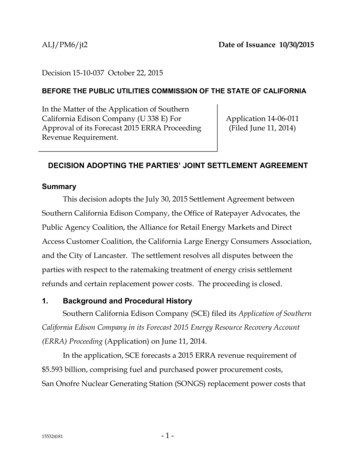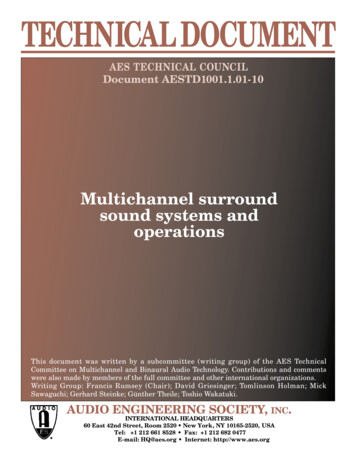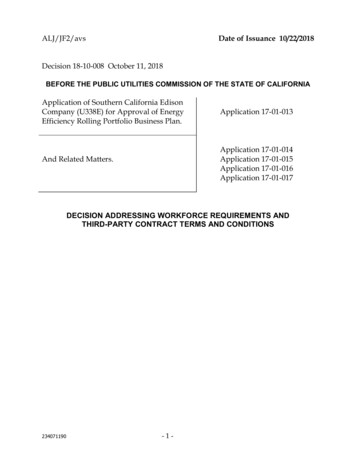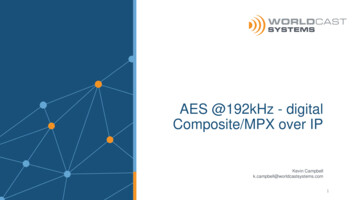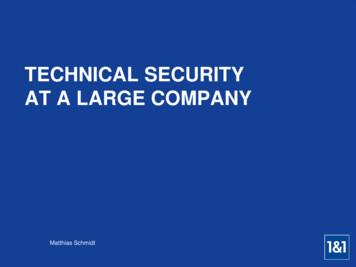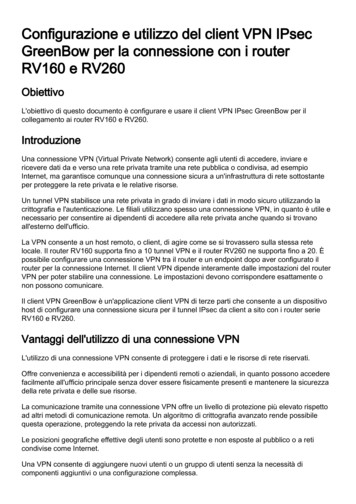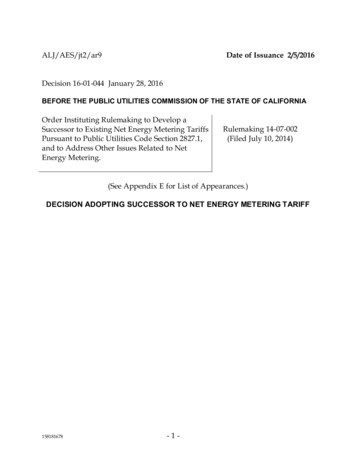
Transcription
ALJ/AES/jt2/ar9Date of Issuance 2/5/2016Decision 16-01-044 January 28, 2016BEFORE THE PUBLIC UTILITIES COMMISSION OF THE STATE OF CALIFORNIAOrder Instituting Rulemaking to Develop aSuccessor to Existing Net Energy Metering TariffsPursuant to Public Utilities Code Section 2827.1,and to Address Other Issues Related to NetEnergy Metering.Rulemaking 14-07-002(Filed July 10, 2014)(See Appendix E for List of Appearances.)DECISION ADOPTING SUCCESSOR TO NET ENERGY METERING TARIFF158181678-1-
R.14-07-002 ALJ/AES/jt2/ar9Table of ContentsTitlePageDECISION ADOPTING SUCCESSOR TO NET ENERGY METERING TARIFF . 1Summary . 21. Procedural History . 51.1. Public Tool. 61.2. Policy Issues and Parties’ Proposals . 81.3. Evidentiary Hearings . 91.4. Assembly Bill 693. 112. Discussion . 112.1. Introduction and Plan of this Decision . 112.2. Overview of NEM Program . 122.2.1. Virtual Net Metering. 152.2.2. Net Energy Metering Aggregation . 152.2.3. This Proceeding . 162.3. Regulatory Context. 172.3.1. Residential Rate Design . 172.3.2. Residential Time of Use Rates . 192.3.3. Work Related to Distributed Energy Resources. 202.4. Party Proposals . 222.4.1. Successor Tariff or Contract . 232.4.2. Maintain Full Retail Rate NEM . 232.4.2.1. CALSEIA . 232.4.2.2. SEIA/Vote Solar. 242.4.2.3. Sierra Club . 252.4.2.4. TASC . 252.4.2.5. Federal Agencies . 252.4.3. Maintain Full Retail Rate NEM With a Demand or InstalledCapacity Charge . 262.4.3.1. NRDC . 262.4.3.2. ORA . 272.5. Customers Use Generation to Serve Onsite Usage, Receive ReducedCompensation for Exports, and Pay a Demand or Installed CapacityCharge. 282.5.1. PG&E . 282.5.2. SCE. 302.5.3. SDG&E . 32-i-
R.14-07-002 ALJ/AES/jt2/ar9Table of Contents (cont.)TitlePage2.6.“Value of Renewables” Tariff Using Avoided Cost . 322.6.1. CAlifornians for Renewable Energy. 322.6.2. SDG&E . 332.6.3. TURN. 342.7. Systems Larger Than 1 MW . 362.7.1. Background . 362.7.2. Party Proposals . 362.7.3. Alternatives for Growth in Disadvantaged Communities . 372.7.3.1. CEJA . 382.7.3.2. GRID Alternatives . 382.7.3.3. IREC . 392.7.3.4. PG&E. 392.7.3.5. SCE . 402.7.3.6. SDG&E . 402.7.3.7. ORA . 412.7.3.8. TURN . 412.7.3.9. SEIA/Vote Solar. 422.7.4. Safety, Consumer Protection, Customer Education. 422.7.4.1. Safety . 422.7.4.2. Consumer Protection . 432.7.4.2.1. Warranties . 432.7.4.2.2. Disclosures and Standardized Practices. 442.7.5. Miscellaneous Proposals. 452.7.6. Evaluation of Proposals for Successor Tariff or Contract. 452.7.6.1. Policy Questions and Their Setting . 452.7.6.2. Policy Setting . 462.8. The Public Tool . 482.9. “Continues to Grow Sustainably”. 502.10. “Total Benefits of the Standard Contract or Tariff to All Customers andthe Electrical System are Approximately Equal to the Total Costs” . 542.11. Evaluation of Specific Proposals . 612.11.1. “Value of Renewables” Tariffs/Contracts . 612.11.2. NEM With Reduced Compensation, Added Charges . 642.11.3. PG&E . 64- ii -
R.14-07-002 ALJ/AES/jt2/ar9Table of Contents (cont.)TitlePage2.11.3.1. Interconnection Fees . 672.11.4. SCE. 682.11.4.1. Interconnection Fees . 702.11.5. SDG&E . 712.11.5.1. Interconnection Fees . 732.11.6. IOU Proposals as a Whole . 742.12. NEM With Installed Capacity Fee or Demand Charge. 762.12.1. ORA . 762.12.2. NRDC . 782.12.3. Maintain Current NEM . 792.13. Evaluation of Proposals Related to Safety, Consumer Protection andRelated Issues. 822.14. Successor Tariff: Realigned NEM. 852.14.1. Aligning Customer Responsibilities . 862.14.1.1. Interconnection. 872.14.1.2. Nonbypassable Charges . 882.14.1.3. Time-of-Use Rates . 912.14.2. Standby Charges. 942.14.3. Annual True-Up Period . 942.14.4. Systems Larger than 1 MW . 952.14.4.1. CDCR. 962.14.4.2. Customer Generators Eligible Under SB 83. 972.14.5. Virtual Net Metering. 982.14.6. Net Energy Metering Aggregation . 992.14.7. Direct Access Customers and Customers of CommunityChoice Aggregation . 1002.15. Duration of Service Under NEM Successor Tariff. 1002.16. Safety and Consumer Protection. 1012.17. Alternatives for Disadvantaged Communities . 1013. Next Steps . 1023.1. NEM successor tariff . 1023.2. Alternatives for disadvantaged communities . 1033.3. Consumer protection and safety . 1033.4. Work by Energy Division staff . 103- iii -
R.14-07-002 ALJ/AES/jt2/ar9Table of Contents (cont.)TitlePage4. Comments on Proposed Decision. 1045. Assignment of Proceeding . 106Findings of Fact. 106Conclusions of Law . 113ORDER. 119Appendix A – Public Utilities Code Section 2827.1Appendix B – Public Utilities Code Section 2827(b)(4)(A)Appendix C – Summary of Standard Practice Manual Cost TestsAppendix D – Summary Tables of Public Tool ResultsAppendix E – List of Appearances- iv -
R.14-07-002 ALJ/AES/jt2/ar9DECISION ADOPTING SUCCESSOR TO NET ENERGY METERING TARIFFSummaryThis decision implements some of the provisions of Assembly Bill (AB) 327(Perea), Stats. 2013, ch. 611. AB 327, among other things, adds Section 2827.1 tothe Public Utilities Code, requiring the Commission to develop “a standardcontract or tariff, which may include net energy metering (NEM), for eligiblecustomer-generators with a renewable electrical generation facility that is acustomer of a large electrical corporation.”In this decision, the Commission: Ensures that customer-sited renewable distributed generationcontinues to grow sustainably by creating a successor to theexisting NEM tariff that includes a new NEM tariff, withmodifications; Follows the fundamental approach to residential rate reformexpressed in Decision (D.) 15-07-001, byo Declining to impose any demand charges, grid access charges,installed capacity fees, standby fees, or similar fixed chargeson NEM residential customers while the Commission isworking on how, if at all, any such fees should be developedfor residential customers;o Continuing to rely on the minimum bill established inD.15-07-001 as a mechanism for ensuring that customers usingthe NEM successor tariff contribute through their billpayments to the costs of maintaining the services of theelectric grid for all customers;o Maintaining the requirement that non-residential NEMcustomers pay any demand charges, standby fees, or similarfixed charges that are part of the underlying rate for theircustomer class, regardless of the requirements of the NEMtariff under which they receive service.-2-
R.14-07-002 ALJ/AES/jt2/ar9 Continues the basic features of the current NEM tariff into thesuccessor NEM tariff, but makes changes that:o Require customers installing customer-sited renewable DGsystems to pay a reasonable interconnection fee to theinterconnecting investor-owned utility (IOU), with anexception for customers participating in the Single-FamilyAffordable Solar Homes program;o Require customers on the NEM successor tariff to paynonbypassable charges that are levied on each kilowatt-hour(kWh) of electricity the customer obtains from the IOU in eachmetered time interval, regardless of the monthly netting of thekWh obtained from the IOU and exported to the grid by thecustomer;o Require all residential customers interconnecting under theNEM successor tariff prior to the institution of defaultresidential any time of use (TOU) rates to take service on anyTOU rate available to them, as a condition of using the NEMsuccessor tariff, except that residential customers of San DiegoGas & Electric Company (SDG&E) will not be required to takeservice on a TOU rate until after the TOU rates beingdeveloped in Application (A.) 15-04-012 are in effect;o Provide NEM successor tariff customers who take service onTOU rates prior to the effective date of default TOU rates forall residential customers with the opportunity to remain onthe TOU rate they have chosen for up to five years;o Allow residential customers of SDG&E who complete theirinterconnection applications for the NEM successor tariff priorto the time the TOU rates for SDG&E residential customersbeing developed in SDG&E’s General Rate Case Phase 2,A.15-04-012, are in effect, to participate in the NEM successortariff while taking service on SDG&E’s existing tiered rates,with the option to maintain their tiered rate for up tofive years;o After the implementation of default TOU rates for residentialcustomers, require all residential NEM successor tariffcustomers, regardless of their date of interconnection, to be on-3-
R.14-07-002 ALJ/AES/jt2/ar9any applicable TOU rate as a condition of taking service underthe NEM successor tariff, with a limited exception for certainSDG&E residential customers. Extends eligibility for the NEM successor tariff to customer-sitedfacilities larger than one megawatt in size, so long as thecustomer pays all Rule 21 interconnection study and distributionsystem upgrade fees for the facility; Establishes minimum warranty and equipment safetyrequirements for installations for customers taking service underthe NEM successor tariff; Determines that the Virtual Net Metering (VNM) tariff and netmetering aggregation (NEMA) sub-schedule of the NEM tariffshould be maintained and updated consistent with the provisionsof the NEM successor tariff established by this decision; Provides that customer-generators may continue to take serviceunder the NEM successor tariff established by this decision for20 years from the year of interconnection of the customer’ssystem; Determines that a better understanding of the impact ofcustomer-sited distributed resources on the electric system willbe developed from work currently under way but not yetcompleted in other Commission proceedings, including but notlimited to the distribution resources plan proceeding(Rulemaking (R.) 14-08-031), the integrated distributed energyresources proceeding (R.14-10-003), and the recently openedrulemaking to consider technical issues for future TOU rates(R.15-12-012); Identifies the year 2019, which the Commission has selected asthe target for beginning default TOU rates for residentialcustomers, as the appropriate time to review the NEM successortariff established by this decision, with a view to consideringadjustments to the successor tariff that include an exportcompensation rate for NEM successor tariff customers that takesinto account locational and time-differentiated values;-4-
R.14-07-002 ALJ/AES/jt2/ar9 Authorizes the Director of Energy Division to direct thedevelopment, in consultation with the parties, of a method ofevaluating whether the NEM successor tariff results in growth ofcustomer-sited renewable distributed generation, consistent withthe methodology established by this decision; Authorizes the Director of Energy Division to take appropriatesteps to prepare for further work in this proceeding, includingbut not limited to, convening workshops led by Energy Divisionstaff, producing staff reports, developing information forpotential NEM successor tariff customers, and similar work; Requires Pacific Gas and Electric Company, Southern CaliforniaEdison Company, and SDG&E, each to submit a Tier 2 adviceletter, with its NEM successor tariff, including NEMA, and VNMtariff, in conformity with the provisions set out in this decision,within 30 days after the effective date of this decision; and Determines that in order to develop the alternatives forresidential customers in disadvantaged communities, and morefully develop the means for effectuating consumer protection andevaluation measures for the NEM successor tariff, a second phaseof this proceeding should be initiated.This proceeding remains open.1.Procedural HistoryThe Order Instituting Rulemaking (OIR) for this proceeding was adoptedby the Commission on July 10, 2014.1 A prehearing conference (PHC) was held1Comments on the OIR were filed on August 18, 2014 by California Energy Storage Alliance(CESA); California Farm Bureau Federation (Farm Bureau); CAlifornians for Renewable Energy(CARE); Clean Coalition; Community Alliance with Family Farmers (CAFF); InterstateRenewable Energy Council (IREC); Local Government Sustainable Energy Coalition (LGSEC);Marin Clean Energy (MCE); Pacific Gas and Electric Company (PG&E); Southern CaliforniaEdison Company (SCE); San Diego Gas & Electric Company (SDG&E); The Alliance for SolarChoice (TASC); and The Utility Reform Network (TURN).Reply comments were filed on August 26, 2014 by California Environmental Justice Alliance(CEJA); California Solar Energy Industries Association (CALSEIA); IREC, Office of RatepayerFootnote continued on next page-5-
R.14-07-002 ALJ/AES/jt2/ar9on October 30, 2014.2 The Scoping Memo and Ruling of Assigned Commissioner(Scoping Memo) was issued on January 23, 2015. Because several strands ofwork have been under way simultaneously throughout the proceeding, thisprocedural history is organized according to the topics addressed, each inchronological order.1.1.Public ToolThe Public Tool, as it came to be called in this proceeding, is a spreadsheetmodel that provides a common framework for parties to use to test and evaluateoptions for the net energy metering (NEM) successor tariff. Its development byEnergy Division staff and consultants to staff3 spanned more than a year,beginning prior to the initiation of this proceeding.4Energy Division staff held a workshop on April 23, 2014, to discuss theconcepts involved in developing the Public Tool and the capabilities that thePublic Tool should have. Following the workshop, staff received informalcomments from a number of stakeholders interested in the proposed Public Tool.Energy Division staff held another workshop on August 11, 2014, after theOIR for this proceeding was adopted. In response to the Administrative LawJudge’s (ALJ) Ruling Seeking Post-Workshop Comments (September 5, 2014),Advocates (ORA); PG&E; SCE; Solar Energy Industries Association (SEIA); TASC; andWal-Mart, Sam’s West, and the University of California (jointly; collectively, Walmart).2PHC statements were filed on October 27, 2014 by CALSEIA; SEIA; TASC and The Vote SolarInitiative (Vote Solar), jointly; CARE; CEJA and Sierra Club (jointly); Net Energy MeteringPublic Agency Coalition (NEM-PAC 2.0); IREC; ORA; PG&E; SCE; and SDG&E.3Energy Environmental Economics are the consultants for the development of the PublicTool.4Energy Division staff maintains a section of the Commission’s web site dedicated to the PublicTool. It may be found at http://cpuc.ca.gov/General.aspx?id 3934.-6-
R.14-07-002 ALJ/AES/jt2/ar917 parties filed comments on October 1, 2014; 13 parties filed reply comments onOctober 20, 2014.5 An informal webinar facilitated by the consultants was heldDecember 2, 2014, to further familiarize parties with the status of developing thePublic Tool.The work on the draft of the Public Tool was formalized by the ALJ’sRuling Adopting Specifications for Further Development of Public Tool(December 12, 2014), which identified both elements that would be incorporatedinto the draft Public Tool and elements that would not be. Energy Division staffheld another public workshop on December 16, 2014 to review and discuss thefinal proposed approach, functionality, and user interface of the Public Tool,prior to the issuance of the draft Public Tool.Energy Division staff held a workshop on March 30, 2015, to demonstratethe use of the draft version of the Public Tool. Comments on the draft version ofthe Public Tool were requested in the ALJ’s Ruling Seeking Comment on DraftVersion of Public Tool (April 15, 2015), and were filed on April 28, 2015.6The Public Tool became available for use through the ALJ’s Ruling SettingSpecifications for the Final Version of the Public Tool and Accepting into the5Comments were filed by 350 Bay Area, CESA, CEJA, Farm Bureau, CARE, Clean Coalition,CAFF, IREC, NEM-PAC 2.0., ORA, PG&E, SCE, SDG&E, Sierra Club, TASC, and Vote Solar.Reply comments were filed by Farm Bureau, CEJA, Clean Coalition, CAFF, IREC,NEM-PAC 2.0, ORA, PG&E, SCE, SDG&E, Sierra Club, Silicon Valley Leadership Group(SVLG), and jointly by TASC, CALSEIA, Vote Solar, and SEIA.6Comments were filed by CEJA, CESA, Clean Coalition, Custom Power Solar, FederalExecutive Agencies (Federal Agencies), ORA, PG&E, SCE, SDG&E, Sierra Club, TURN,Vote Solar, and by CALSEIA, SEIA, and TASC jointly. Reply comments were not allowed.-7-
R.14-07-002 ALJ/AES/jt2/ar9Record the Final Version of the Pubic Tool (June 4, 2015).7 Also on that date, theEnergy Division Staff Paper on the AB 327 Successor Tariff or Standard Contract: StaffPaper Demonstrating How to Use the Public tool to Evaluate Options for a Successor toNet Energy Metering (NEM) Tariffs in Compliance with Assembly Bill 327 (Staff TariffPaper) was accepted into the record by the ALJ's Ruling (1) Accepting into theRecord Energy Division Staff Papers on the Assembly Bill (AB) 327 SuccessorTariff or Contract; (2) Seeking Party Proposals for the Successor Tariff orContract; and (3) Setting a Partial Schedule for Further Activities in thisProceeding (Proposal Ruling).1.2.Policy Issues and Parties’ ProposalsIn response to the ALJ's Ruling Seeking Comment on Policy IssuesAssociated with the Development of Net Energy Metering Standard Contract orTariff (February 23, 2015), parties filed comments on March 16, 2015, and replycomments on March 30, 2015.87Subsequent changes were made to the Public Tool, responding both to minor errors that weredetected in the final version and to the changes in residential rate design announced in Decision(D.) 15-07-001; they were addressed in the ALJ’s Ruling Providing Further Instructions forParties’ Proposals and Accepting into the Record Certain Updates to the Public Tool (July 20,2015).Comments were filed by 350 Bay Area, Agricultural Energy Consumers Association (AECA);CALSEIA, SEIA, TASC and Vote Solar, jointly (collectively, Joint Solar Parties); CESA,California Certified Organic Farmers (CCOF); CEJA and Greenlining Institute (Greenlining),jointly; California Municipal Utilities Association (CMUA); Farm Bureau; Clean Coalition;Coalition of California Utility Employees (CUE); GRID Alternatives; Independent EnergyProducers (IEP); IREC; MCE, National Resources Defense Council (NRDC), NRG Energy(NRG), ORA, PG&E, SCE, SDG&E, Sierra Club, SVLG; TURN, NEM-PAC; and Walmart.8Reply comments were filed by 350 Bay Area, AECA, CEJA and Greenlining, CCOF, FarmBureau, Clean Coalition, CMUA, CUE, IEP, IREC, Joint Solar Parties, NEM-PAC, ORA, PG&E,SCE, SDG&E, Sierra Club, and Walmart.-8-
R.14-07-002 ALJ/AES/jt2/ar9As part of the ALJ's Proposal Ruling, the Energy Division Staff PaperPresenting Proposals for Alternatives to the NEM Successor Tariff or Contract forResidential Customers in Disadvantaged Communities in Compliance with AB 327(Staff Disadvantaged Communities Paper) was accepted into the record. In responseto the Proposal Ruling, parties filed their proposals for a successor tariff orcontract, as well as proposals for alternatives for residential customers indisadvantaged communities.9 Parties filed comments on the proposals onSeptember 1, 2015. Reply Comments were filed on September 15, 2015. 101.3.Evidentiary HearingsRequests for evidentiary hearings were made by CARE, SCE, and PG&Eand SDG&E jointly on August 10, 2015. On September 1, 2015, the ALJ's RulingSetting Evidentiary Hearings and Setting a Schedule for Further Activities Priorto Evidentiary Hearings (Hearing Ruling) was issued. The Hearing Ruling9Proposals for both a successor tariff and alternatives for customers in disadvantagedcommunities were filed by ORA, PG&E, SCE, SDG&E, SEIA/Vote Solar, and TURN.Proposals addressing only a successor tariff were filed by CALSEIA, CARE, Farm Bureau,Federal Agencies, NRDC, Sierra Club, and TASC.Proposals addressing only alternatives for residential customers in disadvantaged communitieswere filed by CEJA, GRID Alternatives, and IREC.10Comments were filed by Alliance for Retail Energy Markets (AReM); Brightline DefenseProject (Brightline) /Salvadoran American Leadershp and Educational Fund (SALEF); CCOF;Farm Bureau/Agricultural Energy Consumers Association; CARE; CALSEIA, SEIA, TASC andVote Solar, jointly; CEJA; CESA; City of San Diego; Clean Coalition; CUE; Center for SustainableEnergy (CSE); Everyday Energy; Foundation Windpower; Greenlining Institute (Greenlining);GRID Alternatives; IREC; LGSEC; MASH Coalition; MCE; NEM-PAC 2.0; NLine Energy;NRDC; ORA; PG&E; Recolte Energy; SCE; SDG&E; Sierra Club; TURN; and Wal-Mart.Reply comments were filed by 350 Bay Area; AReM; CMUA; CALSEIA, SEIA and TASC,jointly; CEJA; CSE; Everyday Energy; Foundation Windpower; Greenlining; GRID Alternatives;IREC; MASH Coalition; MCE; NEM-PAC 2.0; NRDC; ORA; PG&E; SCE; SDG&E; Sierra Club;TURN; and Vote Solar.-9-
R.14-07-002 ALJ/AES/jt2/ar9identified the issues on which hearings would be held and set the schedule forsubmission of testimony.11A second PHC was held on September 18, 2015, in accordance with theALJ's Ruling on Prehearing Conference Process and Requesting PrehearingConference Statements (September 4, 2015). PHC statements were filed by20 parties.12 The PHC was followed by the ALJ's Ruling Providing AdditionalInstructions for Testimony, Rebuttal Testimony, and Other Documents(September 25, 2015).Direct testimony was served by CALSEIA, NRDC, ORA, PG&E, SCE, andSDG&E on September 21, 2105. Rebuttal testimony was served by Joint SolarParties, PG&E, and SDG&E on September 30, 2015. The evidentiary hearing washeld October 5-7, 2015. Opening briefs were filed October 19, 2015; reply briefswere filed October 26, 2015.1311The issues identified for hearing were:1. The basis for projections of prices of rooftop solar installations that are differentfrom those used in the Public Tool (CALSEIA);2. The basis for the investor-owned utilities’ proposed charges in the successor tarifffor interconnection of small systems (PG&E; SCE; SDG&E); and3. The basis for any proposed demand charges, capacity fees, standby charges, accessfees, use charges, or other fixed charges for the successor tariff that are different fromthe assumptions used in the Public Tool (NRDC; ORA; PG&E; SCE; SDG&E).12They are: CALSEIA, CEJA, Clean Coalition, MCE, NEM-PAC, NRDC, ORA, PG&E, SCE,SDG&E, Sierra Club, TASC, TURN, Wal-Mart, and SEIA/Vote Solar.13Opening briefs were filed by Joint Solar Parties, NRDC, ORA, PG&E, SCE, SDG&E, andTURN.Reply briefs were filed by CALSEIA, SEIA, and TASC (jointly); CEJA; ORA; PG&E; SCE;SDG&E; Sierra Club; and TURN- 10 -
R.14-07-002 ALJ/AES/jt2/ar91.4.Assembly Bill 693On the final day of evidentiary hearings in this proceeding, the Governorsigned into law AB 693 (Eggman), Stats. 2015, ch. 582. Among other things,AB 693 creates the Multifamily Affordable Solar Roofs Program, and providesthatadoption and implementation of the Multifamily Affordable HousingSolar Roofs Program may count toward the satisfaction of thecommission’s obligation to ensure that specific alternatives designed forgrowth among residential customers in disadvantaged communities areoffered as part of the standard contract or tariff authorized pursuant toparagraph (1) of subdivision (b) of Section 2827.1. (Pub. Util. Code§ 2870(b)(1).14On October 21, 2015, the ALJ issued a Ruling Seeking Comment on AB 693.Comments were filed November 2, 2015; reply comments were filedNovember 9, 2015.15This matter was submitted on November 9,
Successor to Existing Net Energy Metering Tariffs Pursuant to Public Utilities Code Section 2827.1, and to Address Other Issues Related to Net Energy Metering. Rulemaking 14 -07 002 (Filed July 10, 2014) (See Appendix E for List of Appearances.) DECISION ADOPTING SUCCESSOR TO NET ENERGY METERING TARIFF
